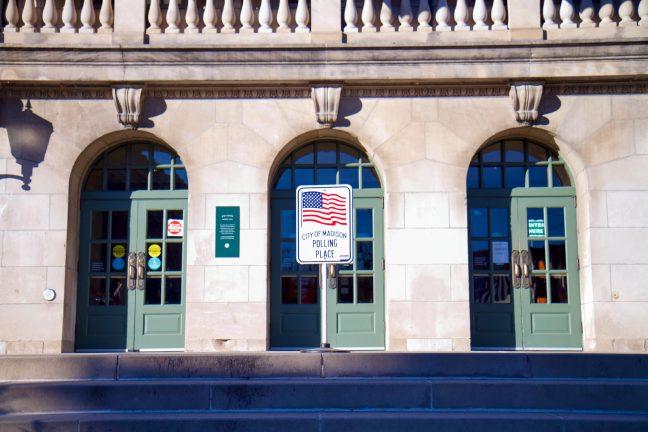Despite recent divisions on voting-related issues, some Wisconsin Republicans and Democrats have united on one issue — ranked-choice voting.
A new bill introducing ranked-choice voting offers Wisconsinites a different way to vote in elections. Currently, Wisconsin has partisan primaries. Before the general election, constituents vote for one candidate and the candidate with the most votes in the primary represents the party in the general election.
Ranked-choice voting would eliminate partisan primaries. Instead, all candidates — regardless of party — would appear on the same ballot and the top five finishers would advance to the general election.
During the general election, a ranked-choice voting system would change the current ballot system by allowing voters to rank the candidates in order of preference from first to fifth. All of the voters’ first choices would be counted and if a candidate gains over 50% of the votes, they win the election.
The system also differs from regular voting procedures because the election is not over until one candidate can secure a majority of the votes. In our current system, whichever candidate receives the most votes wins the election, even if they don’t receive a majority of the votes.
Wisconsin spring primary election turnout was just 7.2%, it is time to reform state voting laws
But in a ranked-choice voting system, if no candidates receive 50% of the votes, the last-place finisher is eliminated. Then, all the votes which list the eliminated candidate as the first choice instead count the second choice. This process repeats until one candidate secures over 50% of the votes.
This system will prevent political polarization which has alienated many moderate voters from both the Democrat and Republican parties, by allowing voters to recast their vote for their second or third favorite candidate if their first choice does not succeed. This will incentivize candidates to appeal more to moderate voters to gain their second or third spot rankings and win particularly competitive elections.
Currently, partisan primaries incentivize candidates to appeal more to ultra-partisan voters since these types of voters participate more in their parties’ primaries, causing many candidates to shift their political stances to reflect their ultra-partisan constituents. But a ranked-choice system could moderate the candidates if the primary is non-partisan.
“Politics is hyper-partisan, it is a lot of bomb-throwing, it is not very productive and the vast majority of people are turned off,” Sen. Dale Kooyenga (R-Brookfield) said to the Wisconsin State Journal. “The system as it’s currently designed rewards behaviors in the tale of bell curves. What this reform does is it gives a broader segment of our population … a say in who the representatives are.”
Republicans and Democrats both cite increasing political polarization as a concern, and show bipartisan support for ranked-choice voting.
“Politics have become increasingly more polarized, which makes it hard for our congressional leaders to get anything done,” Sen. Jeff Smith, D-Brunswick, said in a statement on Tuesday. “‘Final Five’ voting will update our electoral system and help fix the country’s political gridlock.”
The bill would only implement rank-choice voting for Wisconsin elections for U.S. Representatives and Senate seats.
Ranked-choice voting is not unheard of in other states. Maine currently uses ranked-choice voting for its federal elections and Alaska will begin by 2022. Twenty cities, including New York and Minneapolis, also use or will be using ranked-choice voting.
Critics of ranked-choice voting say the system is too complicated and unfairly benefits less popular candidates. They typically claim the system unfairly rewards less popular candidates, citing examples where candidates with fewer first-place votes won elections after multiple rounds of re-tabulating vote results.
But are second-choice candidates really illegitimate winners if voters still listed them on their ballot? The goal of ranked-choice voting is to elect candidates at least half of the constituency approves of.
Just because a voter ranked a candidate lower in preference on their ballot does not mean they still did not choose that person. A voter’s ballot should not be considered any less valid because it counted their second choice.
We need a ranked-choice voting system to allow voters to express their preferences in candidates more clearly. For example, our current voting system discourages third-party candidates because most voters will not “waste their vote” by voting for a candidate with little chance of winning.
Instead, many people vote for one of the front runners even if the candidate does not represent their personal views as accurately. With ranked-choice voting, voters can select both candidates on their ballot so even if their third party choice does not win, their vote can still count for the front runner they also would support.
The current “winner-take-all” voting system allows candidates to avoid gaining bipartisan support because they can win with a plurality of votes. Our current voting system also encourages political polarization as candidates increasingly associate only with the political views of their voting bases.
With a ranked-choice system, only candidates with a true majority of support will be elected and will allow voters to better reflect their political preferences.
“At a time of intense partisanship, we’re in dire need of solutions,” U.S. Rep. for Wisconsin Mike Gallagher said. “This idea is not just a good place to start, but a way for our state to revitalize its rich history in political innovation.”
Hayden Kolowrat ([email protected]) is a graduate student studying Southeast Asian studies.




















